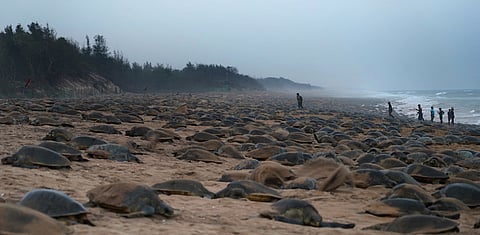

Rising global temperatures mean that more female Olive Ridley turtles are hatching in Odisha’s famous Rushikulya rookery, a new report by non-profit Dakshin Foundation has warned.
This raises questions about the long-term viability of the population, the report, titled Monitoring Sea Turtles in India 2008–2024¸noted.
Rushikulya, located on the mouth of the Rushikulya river in Odisha’s Ganjam district, contributes significantly towards ‘hatchling recruitment’ as it is one of the largest mass nesting rookeries in India.
“Over the last 15 years, we have been monitoring nest temperatures and hatchling sex ratios at the Rushikulya rookery. Determining hatchling sex through gonad histology helps monitor the primary sex ratios of both solitary and arribada nests,” the report read.
Dakshin Foundation researchers found that the hatchling sex ratio from arribadas (mass nesting) at Rushikulya was found to be about 71 per cent female on average.
While some years had extremely female-biased sex ratios due to high nest temperatures, a few years produced male-biased sex ratios.
According to the Dakshin Foundation, sex ratios at Rushikulya were however not as skewed towards females as seen in certain global populations.
The report by Dakshin Foundation is the result of 16 years of research, community involvement, and conservation initiatives centred on Indian sea turtle populations.
Work for the report was carried out in partnership with the Indian Institute of Science (IISc), Bengaluru and several state forest departments.
Monitoring sea turtles is a long-drawn affair as the animals are long-lived, late-maturing, and a highly migratory species. Any changes in their populations occur over years or decades.
Kartik Shanker from IISc and Dakshin Foundation, said the overall trend from nearly two decades of monitoring is that the Olive Ridley population is stable or increasing. “The fact that arribadas don’t occur in some years is puzzling, as our offshore monitoring indicates that there are large numbers of turtles in the water, but it may not be a cause for immediate alarm. Nevertheless, we must remain wary of threats to both coastal and oceanic habitats,” he was quoted in the statement.
The researchers also examined leatherback turtles in the Andaman Islands. They found that leatherback turtle nesting has steadily increased in Little Andaman Island since the 2004 Indian Ocean Tsunami.
“Telemetry studies between 2011 and 2014 showed that these turtles travelled as far west as Madagascar and Mozambique, while others headed as far east as Western Australia,” according to the statement.
A third marine turtle species studied by the researchers were green turtles in Lakshadweep. Their numbers are expanding, bringing about unexpected ecological changes, especially in the seagrass meadows, which are currently being overgrazed.
According to the report, marine turtle populations continue to face threats from issues such as coastal development, pollution and climate change.
“In India, sea turtle foraging and breeding sites overlap with important fishing grounds, affecting coastal livelihoods. A key lesson from this nearly two-decade study is that local communities are primary stakeholders in monitoring and protecting sea turtles. Collaborations among fishers, researchers, and policymakers can lead to more sustainable conservation, benefiting both marine biodiversity and human well-being,” the statement read.